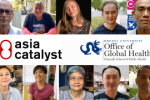By Ken Oh
Last Monday, the United Nations issued a statement applauding the United States and the Republic of Korea for lifting travel bans on people living with HIV/AIDS(PLWHA). The US ban had been in effect for 22 years, and the South Korean ban had been similarly entrenched. Michel Sidibe, executive director of UNAIDS, hailed the parallel policy changes as “a victory for human rights on two sides of the globe”.
What is the significance of these two countries’ policy changes, historically and prospectively? The United States, for one, had maintained its HIV-related travel restrictions since the Reagan Administration. Such a ban has excluded thousands of foreign students, tourists and refugees from American soil, and no significant HIV/AIDS-related conference has been conducted in the United States since 1993. Such conference bodies may have their own official policies of refusing to patronize countries with such unreasonable travel bans, thus robbing the U.S. of a small stream of income from conference visitors. For the United States, the policy change was President Barack Obama’s follow-through on his predecessor’s 2008 verbal commitment to lift the restriction.
For South Korea, the change was equally significant. The country occupies an important political position in the region, and Korean UN Secretary General Ban Ki-moon lauded President Lee Myung-bak’s leadership in ending restrictions with no public health benefit. A 2003 UNAIDS report estimated the number of people living with HIV/AIDS in that country at 8,000. PLWHA in South Korea face the acute and home-grown problems of stigma and discrimination. Among the general public, there are overlapping discriminatory sentiments against foreigners more generally , and against PLWHA .
The travel ban was an overreaction to the inception of the epidemic, as the earliest HIV infections in South Korea occurred mostly through contact with foreigners. However, since 1992 more infections have been transmitted through domestic sexual contacts. Codifying a respect for the human rights of PLWHA could promote a shift in the thinking of the South Korean public — and influence stigma and discrimination the region more broadly.
On the downside, there has not been a statement from the South Korean government indicating that the lifting of the travel ban has any effect on the status of compulsory testing for E-6 entertainment visas (which could influence sex workers traveling to South Korea); it doesn’t appear that it has. According to a statement by the deputy director of the Ministry of Health in September, when the travel ban was discussed, the compulsory testing issue was raised and rejected as a possibility. Compulsory testing also still appears to be required for foreign-language instructors and non-professional employees, though the MOH said they would respect a pending constitutional court decision regarding foreign-language instructors.
Nonetheless, the lifting of these travel bans sends coordinate governmental messages to the world. The U.S. and the ROK are turning their backs on travel policies that were based on neither a scientific nor a public health rationale and that instead reflected unfounded misconceptions about the disease. More practically, these policy shifts attempt to articulate and develop policy approaches to the spread of HIV which do not drive those affected by it underground. According to President Obama, “It’s a step that will encourage people to get tested and get treatment, it’s a step that will keep families together, and it’s a step that will save lives.”
Will these recent actions have broader implications for the international community? Until this year, the United States and South Korea had been part of a sub-set of the international community with such HIV-related travel restrictions. 57 countries still have HIV travel bans, including China, Cuba, North Korea, Israel, Singapore, Iraq and Russia. Many of these countries have strategic, historical, political, or commercial relationships with the United States or South Korea. Human rights advocates, public health professionals, and anyone who supports rational policymaking can hope that the American and South Korean policy changes are not simply isolated actions but rather a sign of building momentum.
An important purpose of a country’s borders is to exclude, to provide a basis for barriers to entry. In the context of international trade, the barriers may be in the form of tariffs or duties. They exist to protect a country’s economic interests. Countries, private corporations and interest groups who feel they have been aggrieved by a foreign country’s restrictions on trade have certain avenues of recourse, including the WTO’s internal dispute settlement mechanism. In the context of travel and migration, however, HIV-related barriers do not protect a country’s interests.
Worse, PLWHA have no legal or political recourse when faced with such exclusion. They can only hope that their destination country, and their own country, will protect their rights.
The recent actions of the US and South Korean governments are important steps in these countries’ treatment of foreigners who have HIV/AIDS, and of the HIV/AIDS epidemic more generally. If these two policy changes are indeed a trend, let’s hope this is one trend that does not go out of style.
Ken Oh is the editor of Asia Report, www.yazhoudiaocha.com.




